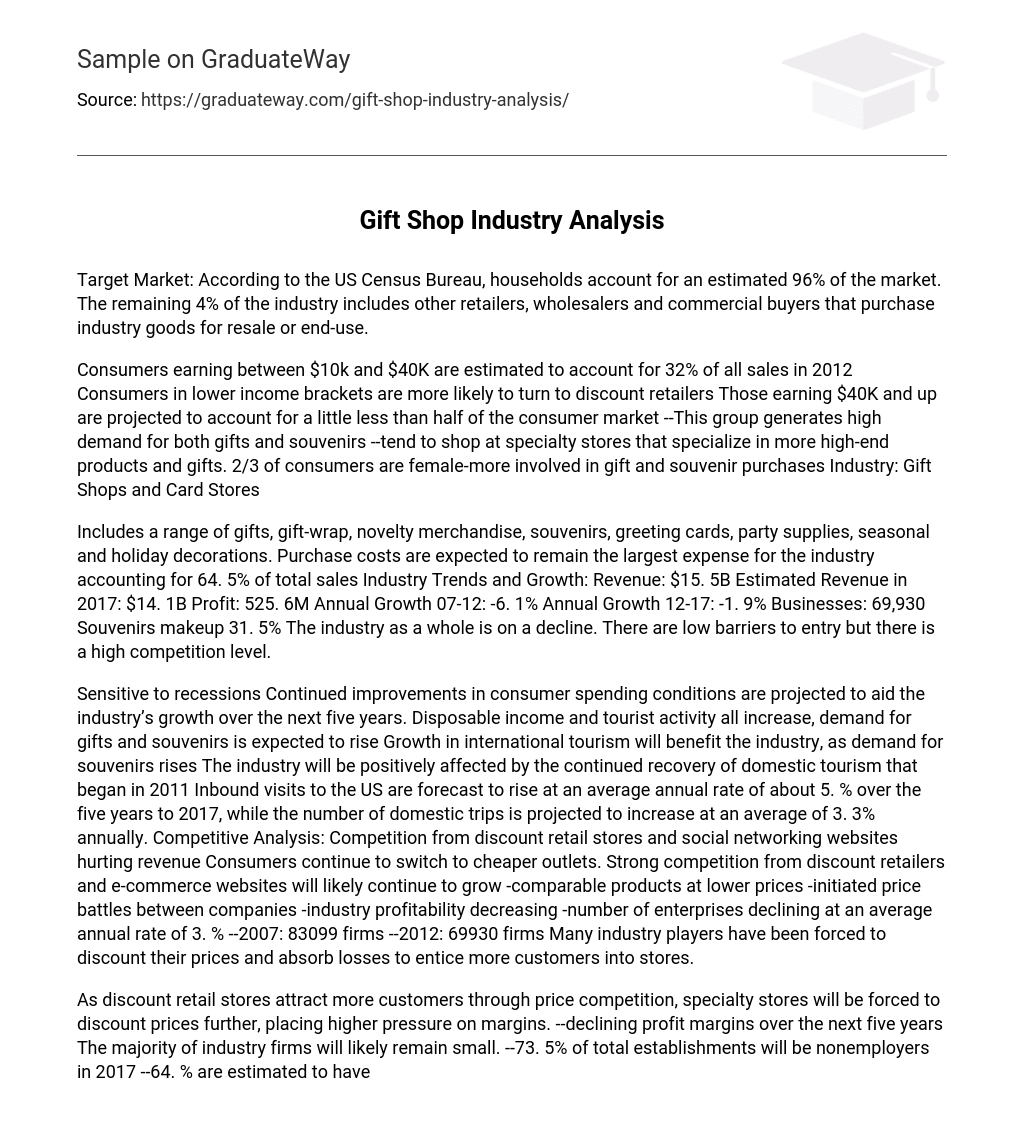Target Market: According to the US Census Bureau, households account for an estimated 96% of the market. The remaining 4% of the industry includes other retailers, wholesalers and commercial buyers that purchase industry goods for resale or end-use.
Consumers earning between $10k and $40K are estimated to account for 32% of all sales in 2012 Consumers in lower income brackets are more likely to turn to discount retailers Those earning $40K and up are projected to account for a little less than half of the consumer market –This group generates high demand for both gifts and souvenirs –tend to shop at specialty stores that specialize in more high-end products and gifts. 2/3 of consumers are female-more involved in gift and souvenir purchases Industry: Gift Shops and Card Stores
Includes a range of gifts, gift-wrap, novelty merchandise, souvenirs, greeting cards, party supplies, seasonal and holiday decorations. Purchase costs are expected to remain the largest expense for the industry accounting for 64. 5% of total sales Industry Trends and Growth: Revenue: $15. 5B Estimated Revenue in 2017: $14. 1B Profit: 525. 6M Annual Growth 07-12: -6. 1% Annual Growth 12-17: -1. 9% Businesses: 69,930 Souvenirs makeup 31. 5% The industry as a whole is on a decline. There are low barriers to entry but there is a high competition level.
Sensitive to recessions Continued improvements in consumer spending conditions are projected to aid the industry’s growth over the next five years. Disposable income and tourist activity all increase, demand for gifts and souvenirs is expected to rise Growth in international tourism will benefit the industry, as demand for souvenirs rises The industry will be positively affected by the continued recovery of domestic tourism that began in 2011 Inbound visits to the US are forecast to rise at an average annual rate of about 5. % over the five years to 2017, while the number of domestic trips is projected to increase at an average of 3. 3% annually. Competitive Analysis: Competition from discount retail stores and social networking websites hurting revenue Consumers continue to switch to cheaper outlets. Strong competition from discount retailers and e-commerce websites will likely continue to grow -comparable products at lower prices -initiated price battles between companies -industry profitability decreasing -number of enterprises declining at an average annual rate of 3. % –2007: 83099 firms –2012: 69930 firms Many industry players have been forced to discount their prices and absorb losses to entice more customers into stores.
As discount retail stores attract more customers through price competition, specialty stores will be forced to discount prices further, placing higher pressure on margins. –declining profit margins over the next five years The majority of industry firms will likely remain small. –73. 5% of total establishments will be nonemployers in 2017 –64. % are estimated to have fewer than 5 employees –6% more than 20 Innovative products, improving product quality and personalized gifts will give stores a competitive edge over the generic stock offered in discount retail stores. –By offering a unique stock at affordable prices, players in the industry can attract more customers to their stores, specifically those looking for new gift ideas Exhibits low level of market share concentration. –the four largest players in the industry are estimated to account for less than 12% of revenue





